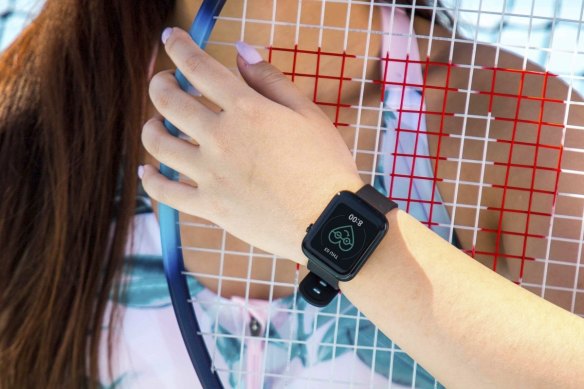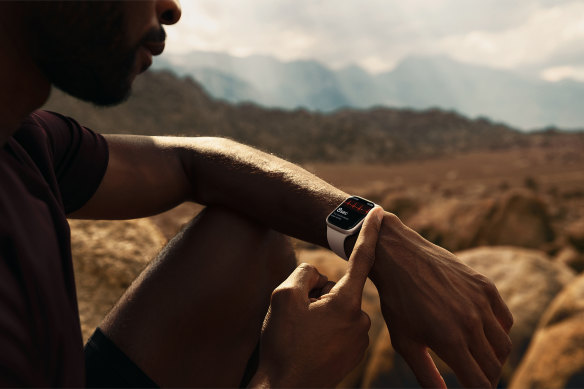By Tim Biggs
Smartwatches and exercise trackers are everywhere, giving people easy access to their physical activity and fitness data. But as wearable devices start sporting more medical features like ECGs and arterial health, it can be hard to tell how much data is too much.
There were 305 million wearable devices shipped globally in 2021, according to ABI research, up from 260 million in 2020. The firm expects that momentum to keep up with around 345 million sold this year. And while almost all of them track steps, sleep, exercise and heart rate, many now go further.
The latest Apple Watches, for example, have clinically validated ECG sensors for detecting atrial fibrillation. Google’s Fitbit is trialling algorithms to detect the same thing using ordinary optical sensors. Samsung’s latest Galaxy watches can do bioimpedance tests to determine your body’s fat and liquid composition. Many devices also estimate your blood oxygen saturation, or blood pressure.

Mobvoi’s latest watch can keep an eye on your arterial health.
Professor Carol Maher from the University of South Australia — who researches how wearable devices help people make better lifestyle choices — said that having diagnostic data collected and charted to show change over time could be powerful, but that on-demand medical tests weren’t necessarily as useful as they may seem.
“Information is power, but that’s kind of within limits. Medical features [on wearables] can be useful, but they’re a bit more in that grey area where they’re not as accurate as medical tests.”
“There is a degree of concern that people may use their watch to substitute a more accurate medical test,” she said.
“Certainly it can potentially help flag an issue that people didn’t realise they had. But it can’t really replace having proper medical tests done.”
Heart disease is the number one cause of death globally, according to the World Health Organisation. And stroke, which is often preceded by atrial fibrillation, is ranked second. So, its no surprise there’s consumer demand for these features. However, professor Maher said the most useful kinds of data in making positive changes were the most basic: information about your movement, exercise, sleep and diet.

The latest watches from Apple and Samsung can take ECGs, and Google’s Fitbit is exploring new ways to monitor for atrial fibrillation.Credit: FDC
“Wearing a wearable doesn’t do it for you. But it certainly can help you understand how much physical activity you’re doing so that you can compare your activity levels to recommendations,” she said.
“And it’s really good for helping you realise the days when you’re really not doing very much at all. People who have low activity levels adjust their expectations down, so they can think their activity levels are reasonable even though in the scheme of the adult population they would actually be quite low.”
A major issue with medical features on watches was context, Professor Maher said. It was no good bombarding people with data about their hearts if they couldn’t work out if it was a cause for concern or what action to take from it. Interface changes that emphasise long-term tracking, rather than worrying about numbers going up or down day-to-day, were a good start.
“As the wearables go further into this kind of territory, they’re going to grapple with how they make the results interpretable to someone who doesn’t have a medical background,” she said, adding that doctors themselves were increasingly open to looking at data collected by patients’ wearables.
“Some GPs are really embracing it. Because at the moment they often would just rely on patients self-reporting what they’ve been doing, which comes down to patient’s memory and ability to describe their lifestyle over an extended period of time.”
While medical features are often found on premium and more expensive wearables, the latest example is a budget $140 device that offers the most basic of smartwatch capabilities (such as exercise, step and sleep tracking, plus phone notifications), alongside arterial analysis based on high-end medical technology.
The TicWatch GTH Pro is the result of a partnership between Google-backed Chinese firm Mobvoi and ASX-listed health tech company CardieX. It’s the first watch to feature the “Arty” platform, which is adapted from SphygmoCor; a widely approved and non-invasive blood pressure solution provided by CardieX subsidiary ATCOR to researchers and clinicians.
“We are basically giving access to what has been a legacy medical IP to the consumer around their vascular health, their arterial health,” said Mark Gorelick, CardieX’s chief product officer.
Mr Gorelick said the company addressed issues of accuracy by including a second PPG (photoplethysmography) sensor on the side of the watch. While most devices have one on the underside to take heart readings through the wrist (and the GTH Pro has one there too), having consumers place their finger on the side sensor provided more useful and detailed data.
“To be honest [a wrist sensor] becomes more of a peak detector. You may get one or two or three features [per beat]. For a stronger pulse wave analysis that measures arterial features, we want to measure a whole host of points along that pulse wave,” he said.
“If you make a change for the better in your lifestyle, we will be able to pick those up directly from a measurement of what’s happening at your heart level. Not as a sort of indifferent proxy that a lot of other people have created in the wearable industry.”
Mr Gorelick said CardieX’s platform was designed to track people’s heart health over weeks and months to show the impact of their life choices on arterial stiffness, exercise capacity and heart stress. He agreed that wearable monitors shouldn’t replace proper medical tests, but said a person having persistent data on how their heart’s performing was a positive thing, even if it made them worried.
“Someone who’s getting consistently low Arty health parameters should be a little anxious, and should be taking a step to improvement. Maybe they have a poor diet, sedentary lifestyle, very stressful job, and this is the first time they’re looking at their heart. It should be somewhat of a wake-up call,” he said.
Get news and reviews on technology, gadgets and gaming in our Technology newsletter every Friday. Sign up here.